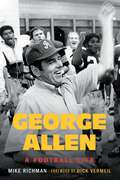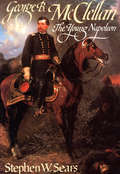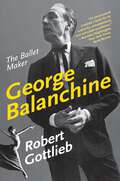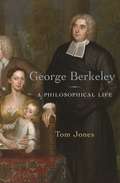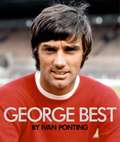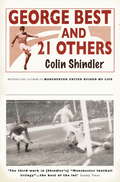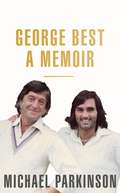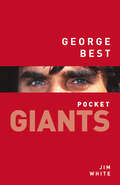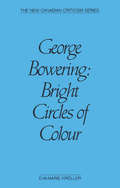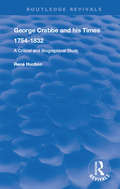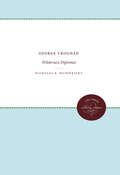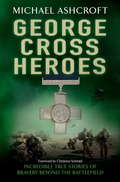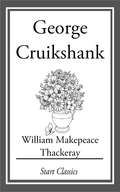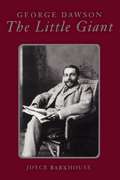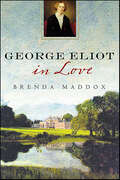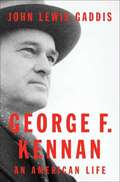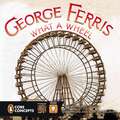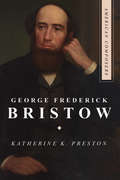- Table View
- List View
George Allen: A Football Life
by Michael RichmanGeorge Allen was a fascinating and eccentric figure in the world of football coaching. His remarkable career spanned six decades, from the late 1940s until his sudden death in 1990 at the age of seventy-three. Although he never won a Super Bowl, he never had a losing season as an NFL head coach and was inducted into the Pro Football Hall of Fame in 2002. In George Allen: A Football Life, Mike Richman captures the life and accomplishments of one of the most successful NFL coaches of all time and one of the greatest innovators in the game. A player&’s coach, Allen was a tremendous motivator and game strategist, as well as a defensive mastermind, and is credited with making special teams a critical focus in an era in which they were an afterthought. He had a keen eye for talent and pulled off masterful trades, often for veteran players who were viewed to be past their prime, who then had great seasons and made his teams much better. In addition to his coaching feats, Allen had an idiosyncratic and controversial personality. His life revolved around football 24-7. One of his quirks was to minimize chewing time by consuming soft foods, giving himself more time to prepare for games and study opponents. He lived and breathed football; he compared losing to death. Allen had contentious relationships with the owners of the two NFL teams for which he was the head coach, the Washington Redskins and Los Angeles Rams. Richman explores why he was fired by those teams and whether he was blackballed from coaching again in the NFL. Based on detailed research and interviews with family, former players, and coaches, George Allen is the definitive biography of the football coach who lived to win, loved a good challenge, and left a lasting legacy on pro football history.
George B. McClellan: The Young Napoleon (Quality Paperbacks Ser.)
by Stephen W. Sears&“Sears has finally unraveled the mystique of this complex, brilliant Civil War general . . . A fascinating story&” (James M. McPherson, author of Battle Cry of Freedom). &“Commander of the Northern army in the Civil War, Gen. George McClellan saw himself as God&’s chosen instrument for saving the Union. Self-aggrandizing, with a streak of arrogant stubbornness, he set himself above President Lincoln, whom he privately called &‘the Gorilla.&’ To &‘the young Napoleon,&’ as McClellan&’s troops dubbed him, abolition was an &‘accursed doctrine.&’ Fond of conspiracy plots, he insisted that the Lincoln administration had traitorously conspired to set him up for military defeat. Although he constantly anticipated one big, decisive battle that would crush the South, he squandered one military opportunity after another, and, if Sears is correct, he was the worst strategist the Army of the Potomac ever had. Based on primary sources, letters, dispatch books, diaries, newspapers, this masterly biography is an astonishing portrait of an egotistical crank who could snatch defeat from the jaws of victory.&” —Publishers Weekly &“Engagingly written and thoroughly researched, Sears&’s persuasive critique is the best and most complete biography of this controversial general.&” —Library Journal &“The best biography of McClellan ever published. Sears uses intensive research, including new material, to document the tormented, wasted military career of a talented man . . . The enigma of McClellan has never been explained so well . . . Historians should be grateful.&” —The Washington Post Book World
George Balanchine: The Ballet Maker (Eminent Lives)
by Robert GottliebThe foremost contemporary choreographer in the history of ballet, George Balanchine extended the art form into radical new paths that came to seem inevitable under his direction. He transformed movement and dance in classical and modern ballet, on the Broadway stage, and in the cinema.George Balanchine chronicles the life and achievements of this visionary artist from his early, almost accidental career in Russia, where his lifelong collaboration with Igor Stravinsky was forged, to his extraordinary accomplishments in America. The editor and writer Robert Gottlieb, one of the most knowledgeable dance critics in America, offers a superb and loving portrait of a genius who, though married many times to many ballerinas, remained truest to his greatest love, Terpischore, the Greek Muse of dance.
George Berkeley: A Philosophical Life
by Tom JonesA comprehensive intellectual biography of the Enlightenment philosopherIn George Berkeley: A Philosophical Life, Tom Jones provides a comprehensive account of the life and work of the preeminent Irish philosopher of the Enlightenment. From his early brilliance as a student and fellow at Trinity College Dublin to his later years as Bishop of Cloyne, Berkeley brought his searching and powerful intellect to bear on the full range of eighteenth-century thought and experience.Jones brings vividly to life the complexities and contradictions of Berkeley’s life and ideas. He advanced a radical immaterialism, holding that the only reality was minds, their thoughts, and their perceptions, without any physical substance underlying them. But he put forward this counterintuitive philosophy in support of the existence and ultimate sovereignty of God. Berkeley was an energetic social reformer, deeply interested in educational and economic improvement, including for the indigenous peoples of North America, yet he believed strongly in obedience to hierarchy and defended slavery. And although he spent much of his life in Ireland, he followed his time at Trinity with years of travel that took him to London, Italy, and New England, where he spent two years trying to establish a university for Bermuda, before returning to Ireland to take up an Anglican bishopric in a predominantly Catholic country.Jones draws on the full range of Berkeley’s writings, from philosophical treatises to personal letters and journals, to probe the deep connections between his life and work. The result is a richly detailed and rounded portrait of a major Enlightenment thinker and the world in which he lived.
George Best
by Ivan PontingGeorge Best was sheer magic. Plucked from the mean streets of Belfast by a canny old scout, he astonished everyone at Old Trafford with his unique gift for the game, bursting into Matt Busby's first team at 17. He starred as Manchester United won the League title in 1964/65 while still in his teens and fame followed. 'El Beatle' became football's first pop idol in 1966 after the match of his life against Benfica in Lisbon. He shone again in 1966/67 as the Red Devils clinched the League title once more and then he was central to the lifting of the European Cup in 1968. Packed full of rare photos and personal insight from the men who knew him best on the pitch, the likes of Sir Bobby Charlton and Denis Law, this book examines the career of a legend, celebrates the talent of a truly exceptional footballer and nods in heartfelt appreciation to the sporting gods who sent George Best to thrill us all.
George Best and 21 Others
by Colin ShindlerIn the spring of 1964 more than 50,000 people turned out to watch the two-legged semi-final of the FA Youth Cup between Manchester City and Manchester United. It was a time of great hope and excitement: a new era was to be ushered in, with the virtues of youth personified in the Beatles and Harold Wilson - and in the teams that played. But what happened next? For some, like George Best, it was the start of a golden era of success; but for others it was the highlight of a career that never happened. In Shindler's compelling third book of his Manchester trilogy, he captures an era of high expectation, talking to many who played in or watched these famous games; but he also movingly portrays what went wrong for others.
George Best and 21 Others
by Colin ShindlerIn the spring of 1964 more than 50,000 people turned out to watch the two-legged semi-final of the FA Youth Cup between Manchester City and Manchester United. It was a time of great hope and excitement: a new era was to be ushered in, with the virtues of youth personified in the Beatles and Harold Wilson - and in the teams that played. But what happened next? For some, like George Best, it was the start of a golden era of success; but for others it was the highlight of a career that never happened. In Shindler's compelling third book of his Manchester trilogy, he captures an era of high expectation, talking to many who played in or watched these famous games; but he also movingly portrays what went wrong for others.
George Best: A unique biography of a football icon perfect for self-isolation
by Michael ParkinsonOne of the most famous footballers of all time, George Best is an icon to football fans all over the world. He lived a tumultuous life, and died in 2005 after battling with alcoholism. He is someone who has crossed over into legend status, with his personal life sometimes overshadowing his footballing prowess. There have been many books written about George, but here, Michael Parkinson combines his professional and personal knowledge of George with his classic and much loved writing style to produce a new, and interesting biography of a football and cultural icon.
George Best: A unique biography of football icon, George Best
by Michael ParkinsonMichael Parkinson and George Best faced one another countless times in interviews. Their conversations were mutually respectful, even intimate, yet always brimming with searching questions and revealing answers.The great Manchester United and Northern Ireland attacker - one of the few sports personalities to merit the term 'iconic' - was almost always candid, lucid and self-effacing. Alcoholism had him in its grip from an early age, affecting the love affairs that fed the tabloid headlines, but there was far more to Best than booze and birds.In George Best: A Memoir, Michael Parkinson draws upon decades of award-winning journalistic experience to re-evaluate a remarkable footballer and a damaged friend. The book weaves together recollections of when the 'the fifth Beatle' ensured it was Manchester, not London or Liverpool, which made the Sixties swing; of Best enjoying a carefree kickabout with the Parkinsons' children in the family garden; and selected transcripts from their endlessly fascinating interviews.'Where did it all go wrong?' is the punchline to a famous Best story. George Best: A Memoir provides Michael Parkinson's considered response to the question while bringing fresh insight into the footballing genius that made Best one of the immortals and the self-destructive side of his character.
George Best: pocket GIANTS
by Jim WhiteOn Sunday 5 October 2014, the 75,000 strong crowd at Old Trafford for Manchester United’s game against Everton joined in with an extended version of a chant which echoed around the stadium. ‘We all live in a Georgie Best world,’ it went. Eleven years after his death, forty years after he walked out of the club for the last time as a player, Best remains a Giant – extraordinary given that his star shone for such a brief time. He was at the top of the game for no more than half a dozen years. How did he do it?
George Bowering: Bright Circles of Colour
by Eva-Marie KröllerThis first book-length study of Bowering explores the relationship between his work and the arts.
George C. Marshall: Ordeal And Hope, 1939-1942
by Forrest PogueMarshall is seen here in all his public and private dealing with the other soldiers, statesmen, and politicians who shaped the course of the war.
George Crabbe and his Times 1754-1832: A Critical and Biographical Study (Routledge Revivals)
by René HuchonThis book was first published in 1968 First appearing in 1907, René Huchon with the help of original manuscripts rewrote the biography of Crabbe published by his son in 1834. As the title suggests, however, Huchon was not merely concerned with the presentation of Crabbe as a literary figure in isolation, and by conjuring up the atmosphere and background of the eighteenth century he is able to shed new light on Crabbe's poetry.There are descriptions of Aldborough, of the desolate heaths and marshy wastes where Crabbe spent his unhappy youth, which together with his background of poverty, and familiarity with the life of the country poor, led him to revolt against the current trend of pastoral poetry. At the time the most detailed study of Crabbe, this work is of foremost importance, for rarely is a poety placed so securely in his setting, and both followers of the poet, and devotees of the eighteenth century will welcome this being freely available agian.
George Croghan: Wilderness Diplomat (Published by the Omohundro Institute of Early American History and Culture and the University of North Carolina Press)
by Nicholas B. WainwrightGeorge Croghan--land speculator, Indian trader, and prominent Indian agent--was a man of fascinating, if dubious, character whose career epitomized the history of the West before the Revolution. This study is based on Croghan's long-lost personal papers that were found by the author in an old Philadelphia attic.Originally published in 1959.A UNC Press Enduring Edition -- UNC Press Enduring Editions use the latest in digital technology to make available again books from our distinguished backlist that were previously out of print. These editions are published unaltered from the original, and are presented in affordable paperback formats, bringing readers both historical and cultural value.
George Cross Heroes
by Michael AshcroftThis ebook edition contains the full text version as per the book; but doesn't include original photographic and illustrated material. In a broadcast to the nation in September 1940 King George VI announced the institution of the George Cross - a civilian equivalent of the Victoria Cross awarded to recognize the many acts of supreme gallantry being performed outside of the battlefield. From Thomas Alderson, the first recipient of the medal, who heroically rescued several people from trapped houses during one terrible Blitz night, to Lance Corporal Matthew Croucher, who threw himself onto a live grenade in the Helmand province to save the lives of his comrades (and somehow survived), to Barbara Harrison, an air stewardess who died in 1968 after helping many passengers escape from an onboard fire, this book tells the amazing stories of everyone of the George Cross's 159 direct recipients. GEORGE CROSS HEROES pays tribute to the extraordinary courage displayed by so many of the commonwealth's men and women in so many incredible situations over the last 70 years.
George Cruikshank
by William Makepeace ThackerayWilliam Makepeace Thackeray (1811-1863) was an English novelist of the 19th century. He was famous for his satirical works, particularly Vanity Fair (1847), a panoramic portrait of English society. Thackeray began as a satirist and parodist, with a sneaking fondness for roguish upstarts like Becky Sharp in Vanity Fair, Barry Lyndon in Barry Lyndon (1844) and Catherine in Catherine (1839). In his earliest works, writing under such pseudonyms as Charles James Yellowplush, Michael Angelo Titmarsh and George Savage Fitz-Boodle, he tended towards the savage in his attacks on high society, military prowess, the institution of marriage and hypocrisy. His writing career really began with a series of satirical sketches now usually known as The Yellowplush Papers, which appeared in Fraser's Magazine beginning in 1837. Between May 1839 and February 1840, Fraser's published the work sometimes considered Thackeray's first novel, Catherine also notable among the later novels are The Fitz-Boodle Papers (1842), Men's Wives (1842), The History of Pendennis (1848), The History of Henry Esmond, Esq., (1852), The Newcomes (1853) and The Rose and the Ring (1855).
George Cukor: A Double Life
by Patrick McGilliganOne of the highest-paid studio contract directors of his time, George Cukor was nominated five times for an Academy Award as Best Director. In publicity and mystique he was dubbed the &“women&’s director&” for guiding the most sensitive leading ladies to immortal performances, including Greta Garbo, Ingrid Bergman, Judy Garland, and—in ten films, among them The Philadelphia Story and Adam&’s Rib—his lifelong friend and collaborator Katharine Hepburn. But behind the &“women&’s director&” label lurked the open secret that set Cukor apart from a generally macho fraternity of directors: he was a homosexual, a rarity among the top echelon. Patrick McGilligan&’s biography reveals how Cukor persevered within a system fraught with bigotry while becoming one of Hollywood&’s consummate filmmakers.
George Dawson: The Little Giant
by Joyce BarkhouseAn exceptional man, George Mercer Dawson (1849-1901) a tiny hunchback, may have contributed more than any other person to early knowledge of the geology, biology and ethnology of Canada’s Northwest. Possessed of a brilliant mind, boundless enthusiasm, an insatiable thirst for knowledge, and a great love of the land, he made some of the most epic exploratory journeys in Canadian history. His maps and reports remain invaluable reference sources. Both Dawson City and Dawson Creek are named in his honour. This book tells the story of some of his life experiences and adventures.
George Did It
by Suzanne Tripp JurmainEveryone wanted George Washington to be the president. He was responsible, led the army in a fight against the British, and helped write the Constitution. But being the president is a very important job, and George was too nervous. So, to everyone surprise, he said no! However, George had many supporters, and with the help of the cheering crowds and loyal advisers and dignitaries, George realized that he didn't have time to think about how nervous he was, he just had to do his job. With little-known facts and a bit of humor, Suzanne Tripp Jurmain gives readers a glimpse into the more personal side of the first president of the United States.
George Eliot in Love
by Brenda MaddoxGeorge Eliot is one of the most celebrated novelists in history. Her books, including Middlemarch, Daniel Deronda, and Adam Bede, are as appreciated now as they were in the nineteenth century. Yet her nonconformist and captivating personal life—a compelling story in itself—is not well known. Ridiculed as an ugly duckling, Eliot violated strict social codes by living with a married man for most of her adult life. Soon after he died, she married a much younger man who attempted suicide during their honeymoon. The obstacles Eliot overcame in her life informed her work and have made her legacy an enduring one. Brenda Maddox brings her lively style to bear on the intersection of Eliot's life and novels. She delves into the human side of this larger-than-life figure, revealing the pleasure and pain behind the intellectual's public face. The result is a deeply personal biography that sheds new light on a woman who lived life on her own terms and altered the literary landscape in the process.
George F. Kennan
by John Lewis GaddisWinner of the Pulitzer Prize Winner of the National Book Critics Circle Award Selected by The New York Times Book Review as a Notable Book of the Year Drawing on extensive interviews with George Kennan and exclusive access to his archives, an eminent scholar of the Cold War delivers a revelatory biography of its troubled mastermind. In the late 1940s, George Kennan wrote two documents, the "Long Telegram" and the "X Article," which set forward the strategy of containment that would define U. S. policy toward the Soviet Union for the next four decades. This achievement alone would qualify him as the most influential American diplomat of the Cold War era. But he was also an architect of the Marshall Plan, a prizewinning historian, and would become one of the most outspoken critics of American diplomacy, politics, and culture during the last half of the twentieth century. Now the full scope of Kennan's long life and vast influence is revealed by one of today's most important Cold War scholars. Yale historian John Lewis Gaddis began this magisterial history almost thirty years ago, interviewing Kennan frequently and gaining complete access to his voluminous diaries and other personal papers. So frank and detailed were these materials that Kennan and Gaddis agreed that the book would not appear until after Kennan's death. It was well worth the wait: the journals give this book a breathtaking candor and intimacy that match its century-long sweep. We see Kennan's insecurity as a Midwesterner among elites at Princeton, his budding dissatisfaction with authority and the status quo, his struggles with depression, his gift for satire, and his sharp insights on the policies and people he encountered. Kennan turned these sharp analytical gifts upon himself, even to the point of regularly recording dreams. The result is a remarkably revealing view of how this greatest of Cold War strategists came to doubt his strategy and always doubted himself. This is a landmark work of history and biography that reveals the vast influence and rich inner landscape of a life that both mirrored and shaped the century it spanned.
George F. Kennan: An American Life
by John Lewis GaddisSelected by The New York Times Book Review as a Notable Book of the Year. Drawing on extensive interviews with George Kennan and exclusive access to his archives, an eminent scholar of the Cold War delivers a revelatory biography of its troubled mastermind. In the late 1940s, George Kennan wrote two documents, the "Long Telegram" and the "X Article," which set forward the strategy of containment that would define U.S. policy toward the Soviet Union for the next four decades. This achievement alone would qualify him as the most influential American diplomat of the Cold War era. But he was also an architect of the Marshall Plan, a prizewinning historian, and would become one of the most outspoken critics of American diplomacy, politics, and culture during the last half of the twentieth century. Now the full scope of Kennan's long life and vast influence is revealed by one of today's most important Cold War scholars. Yale historian John Lewis Gaddis began this magisterial history almost thirty years ago, interviewing Kennan frequently and gaining complete access to his voluminous diaries and other personal papers. So frank and detailed were these materials that Kennan and Gaddis agreed that the book would not appear until after Kennan's death. It was well worth the wait: the journals give this book a breathtaking candor and intimacy that match its century-long sweep. We see Kennan's insecurity as a Midwesterner among elites at Princeton, his budding dissatisfaction with authority and the status quo, his struggles with depression, his gift for satire, and his sharp insights on the policies and people he encountered. Kennan turned these sharp analytical gifts upon himself, even to the point of regularly recording dreams. The result is a remarkably revealing view of how this greatest of Cold War strategists came to doubt his strategy and always doubted himself. This is a landmark work of history and biography that reveals the vast influence and rich inner landscape of a life that both mirrored and shaped the century it spanned.<P><P> Pulitzer Prize winner
George Ferris, What a Wheel! (Penguin Core Concepts)
by Barbara LowellHave you ever ridden a Ferris wheel? You go up, up, up and can see for miles! But when the inventor of the Ferris wheel, George Ferris, first pitched the idea, everyone thought he was crazy. A 250-foot bicycle wheel that goes around and around and carries people in train cars? Can't be done, they said. But George proved them wrong. Read about how George's hard work, courage, and imagination created one of the most famous fair rides today.George Ferris, What a Wheel covers the concepts Imagination and Problem Solving.
George Frederick Bristow: Symphony No. 2 In D Minor, Op. 24 ( Jullien ) (American Composers)
by Katherine K. PrestonAs American classical music struggled for recognition in the mid-nineteenth century, George Frederick Bristow emerged as one of its most energetic champions and practitioners. Katherine K. Preston explores the life and works of a figure admired in his own time and credited today with producing the first American grand opera and composing important works that ranged from oratorios to symphonies to chamber music. Preston reveals Bristow's passion for creating and promoting music, his skills as a businessman and educator, the respect paid him by contemporaries and students, and his tireless work as both a composer and in-demand performer. As she examines Bristow against the backdrop of the music scene in New York City, Preston illuminates the little-known creative and performance culture that he helped define and create. Vivid and richly detailed, George Frederick Bristow enriches our perceptions of musical life in nineteenth-century America.
